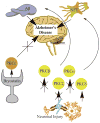Common mechanisms of Alzheimer's disease and ischemic stroke: the role of protein kinase C in the progression of age-related neurodegeneration
- PMID: 25114088
- PMCID: PMC4446718
- DOI: 10.3233/JAD-141422
Common mechanisms of Alzheimer's disease and ischemic stroke: the role of protein kinase C in the progression of age-related neurodegeneration
Abstract
Ischemic stroke and Alzheimer's disease (AD), despite being distinct disease entities, share numerous pathophysiological mechanisms such as those mediated by inflammation, immune exhaustion, and neurovascular unit compromise. An important shared mechanistic link is acute and chronic changes in protein kinase C (PKC) activity. PKC isoforms have widespread functions important for memory, blood-brain barrier maintenance, and injury repair that change as the body ages. Disease states accelerate PKC functional modifications. Mutated forms of PKC can contribute to neurodegeneration and cognitive decline. In some cases the PKC isoforms are still functional but are not successfully translocated to appropriate locations within the cell. The deficits in proper PKC translocation worsen stroke outcome and amyloid-β toxicity. Cross talk between the innate immune system and PKC pathways contribute to the vascular status within the aging brain. Unfortunately, comorbidities such as diabetes, obesity, and hypertension disrupt normal communication between the two systems. The focus of this review is to highlight what is known about PKC function, how isoforms of PKC change with age, and what additional alterations are consequences of stroke and AD. The goal is to highlight future therapeutic targets that can be applied to both the treatment and prevention of neurologic disease. Although the pathology of ischemic stroke and AD are different, the similarity in PKC responses warrants further investigation, especially as PKC-dependent events may serve as an important connection linking age-related brain injury.
Keywords: Alzheimer's disease; blood-brain barrier; immune exhaustion; innate immunity; ischemic stroke; protein kinase C.
Figures



Similar articles
-
Postischemic dementia with Alzheimer phenotype: selectively vulnerable versus resistant areas of the brain and neurodegeneration versus β-amyloid peptide.Folia Neuropathol. 2012;50(2):101-9. Folia Neuropathol. 2012. PMID: 22773455 Review.
-
Cerebral Hypoperfusion and Other Shared Brain Pathologies in Ischemic Stroke and Alzheimer's Disease.Transl Stroke Res. 2018 Jun;9(3):238-250. doi: 10.1007/s12975-017-0570-2. Epub 2017 Oct 2. Transl Stroke Res. 2018. PMID: 28971348 Free PMC article. Review.
-
Alzheimer's mechanisms in ischemic brain degeneration.Anat Rec (Hoboken). 2009 Dec;292(12):1863-81. doi: 10.1002/ar.21018. Anat Rec (Hoboken). 2009. PMID: 19943340 Review.
-
Proteomic and Genomic Changes in Tau Protein, Which Are Associated with Alzheimer's Disease after Ischemia-Reperfusion Brain Injury.Int J Mol Sci. 2020 Jan 30;21(3):892. doi: 10.3390/ijms21030892. Int J Mol Sci. 2020. PMID: 32019137 Free PMC article. Review.
-
Decline of microtubule-associated protein tau after experimental stroke in differently aged wild-type and 3xTg mice with Alzheimer-like alterations.Neuroscience. 2016 Aug 25;330:1-11. doi: 10.1016/j.neuroscience.2016.05.013. Epub 2016 May 14. Neuroscience. 2016. PMID: 27189884
Cited by
-
Role of neurotoxicants in the pathogenesis of Alzheimer's disease: a mechanistic insight.Ann Med. 2021 Dec;53(1):1476-1501. doi: 10.1080/07853890.2021.1966088. Ann Med. 2021. PMID: 34433343 Free PMC article. Review.
-
Protein Kinase C Involvement in Neuroprotective Effects of Thymol and Carvacrol Against Toxicity Induced by Amyloid-β in Rat Hippocampal Neurons.Basic Clin Neurosci. 2022 May-Jun;13(3):295-304. doi: 10.32598/bcn.2021.666.2. Epub 2022 May 1. Basic Clin Neurosci. 2022. PMID: 36457884 Free PMC article.
-
Transcriptomic analysis identifies shared biological foundations between ischemic stroke and Alzheimer's disease.Front Neurosci. 2022 Nov 18;16:1008752. doi: 10.3389/fnins.2022.1008752. eCollection 2022. Front Neurosci. 2022. PMID: 36466169 Free PMC article.
-
Gender- and region-specific changes in estrogen signaling in aging rat brain mitochondria.Aging (Albany NY). 2018 Aug 31;10(8):2148-2169. doi: 10.18632/aging.101538. Aging (Albany NY). 2018. PMID: 30169330 Free PMC article.
-
A PKCη missense mutation enhances Golgi-localized signaling and is associated with recessively inherited familial Alzheimer's disease.Sci Signal. 2025 Jul;18(893):eadv0970. doi: 10.1126/scisignal.adv0970. Epub 2025 Jul 1. Sci Signal. 2025. PMID: 40591711 Free PMC article.
References
-
- Cai HY, Holscher C, Yue XH, Zhang SX, Wang XH, Qiao F, Yang W, Qi JS. Lixisenatide rescues spatial memory and synaptic plasticity from amyloid beta protein-induced impairments in rats. Neuroscience. 2014;277C:6–13. - PubMed
-
- Sutovsky S, Blaho A, Kollar B, Siarnik P, Csefalvay Z, Dragasek J, Turcani P. Clinical accuracy of the distinction between Alzheimer’s disease and frontotemporal lobar degeneration. Bratisl Lek Listy. 2014;115:161–167. - PubMed
-
- Sun MK, Alkon DL. The “memory kinases”: Roles of PKC isoforms in signal processing and memory formation. Prog Mol Biol Transl Sci. 2014;122:31–59. - PubMed
-
- Liu SJ, Gasperini R, Foa L, Small DH. Amyloid-beta decreases cell-surface AMPA receptors by increasing intracellular calcium and phosphorylation of GluR2. J Alzheimers Dis. 2010;21:655–666. - PubMed
Publication types
MeSH terms
Substances
Grants and funding
LinkOut - more resources
Full Text Sources
Other Literature Sources
Medical

